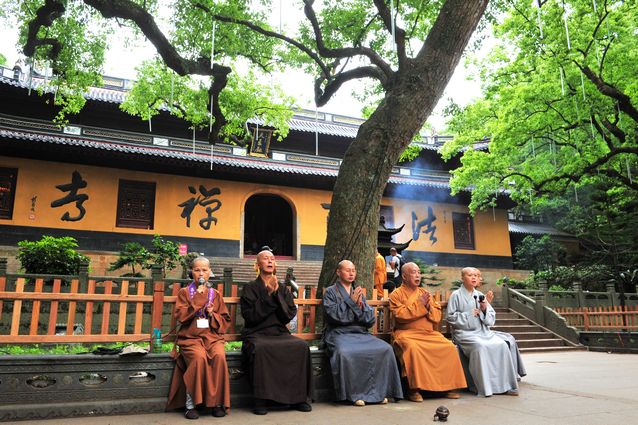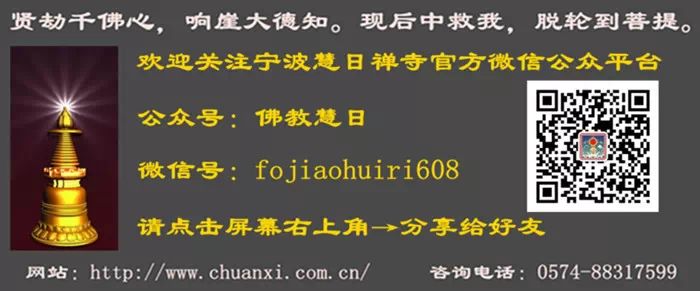传喜法师开示:普陀山朝圣之旅(一)

公元2012年5月28日, 天朗气清,慧日高悬,海天佛国普陀山迎来了一支人数众多的朝圣团。他们从台湾、马来西亚 、印尼、新加坡等地远道而来。近三百人的朝圣团中,大多数人是生平第一次来到普陀山。他们在传喜法师的引领下,三步一拜 ,虔诚顶礼大慈大悲观世音菩萨。慈悲之旅的诸位菩萨们,大家从山门三步一叩,用我们的身体来向圣者礼敬。一是降服自心,第二也是能够感染过往的所有朝圣的众生。在我们的礼拜过程当中, 我看到很多的朝圣者也会加入到我们的队伍里来。所有路过看到我们的人,都会内心里升起对观音菩萨的礼赞,也是对我们修行的随喜。
不肯去观音院是普陀山之行中必到的一处圣地,因为这里是一切传奇的开始。一千多年前,有一位日本僧人慧锷,从五台山请得一尊观世音菩萨像渡海回国,船行至舟山群岛洋面时,风浪大作,海水中还出现了不可思议的景象。船开不动。为什么开不动?形成了铁的,好像铁莲花,铁莲花让这个船没有办法再往前开。所以祂觉得这应该是观音菩萨显灵。祂就拜观音菩萨:“如果您不愿意去日本的话,把你供在这里好吗?”结果这样一祝愿铁莲花就全部消失了。祂没办法就下船靠岸,靠岸之后就在这边上帮观音菩萨搭了个茅棚把观音菩萨供在这里。
所以,中国的四大名山——文殊菩萨是来自印度的,观音菩萨是日本人在这里发起的,九华山的地藏菩萨是韩国的金乔觉发起的。所以我们佛教就是一个国际大家庭。
不肯去观音院外的石桥下有一古洞 名“潮音洞”。 十米深的洞下海潮奔腾、浪花飞溅、虹霓幻现、叹为奇观。我们这个潮音洞也是普陀山的一个圣地。这里是听。潮音洞是听这个声音,修观音菩萨的修行。就是这一种修法叫"紫竹林中观自在"。我们后面是紫竹林,紫竹林寺。这边就是潮音。梵音海潮音,胜彼世间音。我们到这边听听潮水,就会把我们心中的烦恼给洗掉,我们的心就静下来跟观音菩萨相应。
走过睡莲盛开,鱼儿嬉游的海印池,便来到普陀山的核心——普济寺。这座供奉毗卢观音身像的古刹是普陀山最大的寺院。曾享尽文官下轿,武官下马的殊荣,也曾历经千年风雨数次兴废。以前我师父首先来到普陀山就是住在这里。从1979年回普陀山修复普陀山,师父那个时候再回来的时候,这地方已经是满目疮痍,遍地野草,佛菩萨的像全部被打破了。有的佛头在草堆里, 那时候 师父回来了, 把佛像佛头拿起来拿一块围裙围好,给祂早晚磕头敬香,然后他们再开始慢慢地修复。
从1979年开始,后来十几年时间,也一直是我们师父在这里大殿里每天带领大家做早晚课,然后晚上带领弟子们在这个地方打坐。因为在普陀山夏天还是蛮热的,虽然是一个海岛,但是这个海岛蛮奇怪,蛮聚气的。晚上一直要热到12点钟以后。所以师父带领弟子们在这里打坐,讲一些开示。所以那个时候,早期的我师父剃度的那些弟子都成为现在普陀山的顶梁柱, 基本上都是现在各寺院的当家。也是因为在那样的一个背景下,所以师父带出的这些徒弟都是非常优秀的弟子。到现在我们的大师兄还保持着这个习惯。像我们现在普济寺的前当家净妙法师,他到现在还保持着夜不倒单,整晚不睡觉。他房间没有床的,就是一个禅凳,那时候就是在这里培养出来的。师父带领大家在这边彻夜地在这里打坐,慢慢地培养起大家这样一种道心。所以普陀山还是有真修行,普陀山还是有很好的修行者在这里。所以我们不仅观音菩萨香火兴旺,这里面出家人也是非常好的。像普济寺现在还是有很多的出家人,做早晚功课的时候威仪整肃、非常庄严。
在大圆通殿中,传喜法师引领四众弟子在观世音菩萨座侧,念诵《妙法莲华经观世音菩萨普门品》全文,以身语意 作大供养。我们刚才在圆通宝殿里面诵《妙法莲华经观世音菩萨普门品》。同时 这个圆通的“因” 又在《楞严经》当中。《楞严经》第二十五圆通,第六卷二十五圆通讲到“从闻思修,入三摩地”。 从这里面讲,佛陀又请文殊菩萨说:“你看,这前面的诸大菩萨都说了自己的修行法门,你们看一下谁对这个世界众生的机?对末法时代众生的机是哪一个法门呢?”文殊菩萨就说:“此方真教体 ,清净在音闻。欲入三摩地,当于闻中入。”耳根最利,我们娑婆世界的耳朵最利。所以 眼只看,眼观什么,眼睛看的范围没有耳朵听的范围广,所以叫“十方俱击鼓 ,十处一时闻”。 每个地方我们站在这里,我讲话你们也听到,别人讲话你也听到。耳朵是很厉害的。但是光听,你的耳朵着外尘着声尘,那么就变生灭法。能够当处回光返照,就回归到我们耳根当中,耳根的佛性。回光到耳根的佛性,一根归源,六根消怠,这个也是能够可以速证佛法,速脱生死。所以这个大圆通殿在哪儿? 大圆通宝殿在你们自己身上。耳根门头都有一个大圆通殿。
离开普济寺,慈悲之旅浩浩荡荡的队伍向西天景区进发。山路蜿蜒、队形迤逦。大家一路遍洒甘露米水 ,挥舞经幡,聆听传喜法师对一处处古物圣迹的慈悲开示。
在磐陀石下,法师点出了一处平时绝难留意的石刻文字。这四个字写的是什么?指我们念佛的时候,或者打坐的时候那个状态,很安静很安静 ——寂寂,但是不能安静得睡着了。所以叫"惺惺寂寂是,寂寂昏沉非"。“寂寂”:如果寂寂的时候,你昏沉了就不对了。“惺惺寂寂”中惺惺是什么意思呢?保持很清楚的状态,同时又很安静 。“惺惺寂寂”是惺惺散乱非。保持很清醒,但是脑子东想西想,这又不对了,所以叫惺惺散乱非。你们记住噢!是修行观音菩萨修行法门的窍诀,就刻在这个金刚磐陀石上——“寂寂惺惺是,寂寂昏沉非。惺惺寂寂是,惺惺散乱非。”大家记住啊!

On the 28th May, 2012, the sky was clear and weather was nice and sunny. The Buddha-land between the sky and the sea, Mount Putuo, received a large group of people on pilgrimage coming afar from Taiwan, Malaysia, Indonesia and Singapore. There were about 300 people in this group, and for many of them this was their first visit to Mount Putuo. Under the guidance of Master Chuanxi, they prostrated themselves after every third step in reverence to Avalokiteśvara of great compassion. Dear bodhisattvas on this trip of compassion,we have started our trip by prostrating ourselves after every third step to venerate the Holy One with our bodies. We do this firstly to subdue our minds; Secondly, to affect all the passersby on their pilgrimage. On our way of pilgrimage, I saw many pilgrims join our procession eventually. All the passersby who saw us would have veneration towards Avalokitesvara arise in their hearts, which is also a praise to our spiritual practice.
The Bu Ken Qu Avalokiteśvara Temple is a holy place that must be visited on your trip to Mount Putuo, as this is where the legend began. More than 1,000 years ago, a Japanese monk named Hui’eh, visited Mount Wutai in request for a statue of Avalokiteśvara. On his way, sailing back to his home country, when the ship came near the coast of Zhoushan archipelagoes, there began a raging storm and there appeared an amazing image on the surface of the sea. The ship was no longer able to move because the water had formed an image of an iron-like lotus flower which trapped the ship. Hui’eh thought that this must be Avalokiteśvara appearing to him. Therefore he prayed to Avalokiteśvara, asking if it was good for him to make this place the site of His devotion since He did not want to go to Japan.The moment he said the prayer, the iron-like lotus flower disappeared. Hui’eh had no choice but to disembark from the ship and go on shore. This is where he disembarked and built a hut to enshrine Avalokiteśvara there.
Of the four famous mountains in China, the Bodhimaṇḍa of Mañjuśrī was built by an Indian; the Bodhimaṇḍa of Avalokiteśvara was started by a Japanese, and the Bodhimaṇḍa of Kṣitigarbha was built by the Korean Kim Gyo-gak. Buddhism is a big family regardless of the boundary of nations.
Beneath the stone bridge outside Bu Ken Qu Avalokiteśvara Temple, there is a very old cave named Chaoyin Dong (the cave of sound of the waves). Ten meters underneath it, water surges and dashes wildly against the rocks, rainbows constantly appear which are quite spectacular. Chaoyin Dong is also a holy place of Mount Putuo. The theme here is to listen. Chaoyin Dong means to hear the sound of the wave. This is one of the methods of practices of Avalokiteśvara, to which there is a saying, “In the Purple Bamboo Grove there is the Avalokiteśvara”. Behind us there is the Purple Bamboo Grove,in which harbors the Purple Bamboo Temple. Here is the “Chaoyin”. Fine and wondrous sound: Guan Shi Yin!Brahma-sound, steady as the tides. If we come here to listen to the sound of the wave, it will wash away all our concerns, quiet down our minds and connect us to Avalokiteśvara.
Walking pass Haiyin Pond, where water lilies are in blossom and fish are gliding the water, we come to the centre of Putuo-Puji Temple. It is the largest antique temple in Mt. Putuo where the statue of Vairocana Avalokiteśvara is consecrated. The temple used to enjoy the honor of worship by numerous officials getting off their palanquins and officers dismounting from their horses. It has also endured the erosion of weather, and many times of prosperity and abandonment. My spiritual leader settled down here the first time he came to Mount Putuo.
In 1979, he came back to Mount Putuo for the reconstruction of the temple. At the time when he came back, it was entirely in desolation covered with weeds. All the statues of Buddhas and Bodhisattvas were damaged. My spiritual leader found the head of the Buddha was cast in the grass so he picked it up and wrapped it up with a cloth. He began to worship and consecrated incense to it and they embarked upon reconstruction bit by bit. Since 1979, over the ten following years, my spiritual leader had conducted morning and evening services with everyone in the hall and led the disciples to meditate here during the night. It is quite hot during the summer in Mount Putuo.Although it is an island, it is still humid and hot which is quite strange. The heat will not start to subside until midnight. That is why my spiritual leader chose to take all his disciples to meditate and preach to them there. Because of this, my spiritual leader’s disciples who had been tonsured earlier all became the backbone of Mount Putuo and the abbots of different temples. And it is also because of this background, that all my spiritual leader’s disciples have become masters. My senior fellow disciple still keeps this habit.Master Jingmiao, the previous abbot of Puji Temple can still stay awake for a whole night. There is no bed in his room, but only a chair for meditation. This is how a master is cultivated. My spiritual leader summoned everyone here and meditated overnight. Therefore, he planted in everyone’s heart the seed of Tao. On Mount Putuo there are real spiritual practitioners here. There are not only numerous people coming to worship Avalokiteśvara, but also many spiritual masters. In Puji Temple, there are many monks who look very august and solemn in their morning and evening practices.
In the Grand Yuantong Hall, Master Chuanxi led all the disciples of monks, nuns and laypersons to chant The Universal Gateway of Avalokitasvara Bodhisattva, at two sides of the statue of Avalokiteśvara as an offering with their body, word and mind. Just now we chanted the The Universal Gateway of Avalokitasvara Bodhisattva in Yuantong Hall. The origin of Yuantong can be traced back into the Śūraṅgama Sūtra. According to the twenty-five means in the sixth chapter, it speaks entering Samadhi through the process of hearing, reflecting and practicing. It also says that Buddha asked Mañjuśrī, ‘Among all the ways of practices of all the Bodhisattvas, which one is the one that fits the conditions of all the sentient beings of this world in the Age of Dharma Decline?’ Mañjuśrī replied:“In this land the true substance of teaching resides in hearing the sounds purely. If one wants to attain Samadhi, hearing is the best way to enter.” The sense of hearing in the Saha World is the sharpest. The eyes can see, but the scope it can reach is not as wide as the ears can reach. When drums are rolled throughout the ten directions,the sounds from all ten locations can be heard at once. Standing here, you can hear when I speak or whoever speaks. Our sense of hearing is very sharp. But if you just listen and are attached to the sound from outside you therefore have the illusion of arising and ceasing. Only through staying present in the light of our Buddha-nature can we return to the sense of hearing, the Buddha-nature of the sense of hearing. Once the Buddha-nature of the sense of hearing is awakened, once a single sense has returned to its origin, all six senses would be tamed. Thus the Dharma is established and samsara is transcended. So the location of the Grand Yuantong Hall is in fact within you. Your senses of hearing all have a Grand Yuantong Hall.
After the visit to PuJi Temple, the procession of the trip of compassion left for Xitian scenic spot. The procession became winding along the rugged paths of the mountain.Everyone was giving alms of water and rice to the hungry ghosts and waving the prayer flags whilst listening to Master Chuanxi’s introduction of the history of every place of antiquity.
Below Pantuo Stone, the master pointed to a stone carving of four characters which can hardly be noticed usually. The meanings of these four characters refer to the state when we are chanting or meditating which is very quiet and still. But not too quiet to fall asleep which is not right. That’s why it says to be clear and quiet is the right thing, to be quiet but muddy is the wrong thing. If you are muddled, then it is not right. Clear and quiet means your mind has to be clear and awake, and quiet at the same time. To be clear and quiet is right, to be clear but disquiet is wrong. If you stay awake but your mind never quiets down, it is not right either. That is why it says to be clear but disquiet is the wrong thing. Keep this in your minds. Carved on this diamond Pantuo Stone is the key to the way of Avalokiteśvara’s monastic practice. Still and clear is right, quiet but muddy is wrong. Awake and still is right, clear but disquiet is wrong. Keep this in your minds!

爱出者爱返,福往者福来。随喜转载,功德无量。
